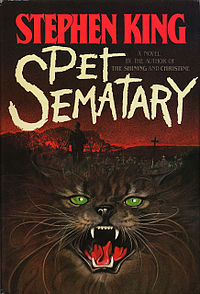When I moved to Stephen King’s home state of Maine last month, I thought it would be fun – if a bit cliché – to finally read his books in earnest, and discover how I really feel about his work. For this installment, I let the Overlook Hotel tell me what to do – unsurprisingly, it chose The Shining.
“Has it ever occurred to you what would happen to my future, if I were to fail to live up to my responsibilities? Has it ever occurred to you? Has it?”
–Jack Torrance
 Even though I’m merely two volumes into this little project of mine, I feel like I have a pretty solid grasp on what makes Stephen King’s best work tick. He doesn’t restrict his creepy crawlies to the supernatural realm, and that’s why his stories have struck such a resounding chord with a wide swath of humanity. Just like Pet Sematary, which twisted the intensity of parental love into something thoroughly unwholesome, The Shining takes a universally understood emotion and holds us hostage with it.
Even though I’m merely two volumes into this little project of mine, I feel like I have a pretty solid grasp on what makes Stephen King’s best work tick. He doesn’t restrict his creepy crawlies to the supernatural realm, and that’s why his stories have struck such a resounding chord with a wide swath of humanity. Just like Pet Sematary, which twisted the intensity of parental love into something thoroughly unwholesome, The Shining takes a universally understood emotion and holds us hostage with it.
The feeling in question here involves the nature of free will, and the frightening implications of its absence. The Shining is as much a classic ghost story as a study of family dynamics, pitting the Torrances – father Jack, mother Wendy, and son Danny – in a battle against not only the hostile spirits of a haunted hotel, but also the rather shoddy track record of its own DNA. After losing his teaching job at a Connecticut prep school because of a violent incident with a student – a job that was already on shaky ground thanks to his alcoholism – Jack takes a job as the winter caretaker of the Overlook, a ritzy, destination hotel high up in the Rocky Mountains. The Torrances will be the only residents in the huge old structure for the entire season, during most of which they will be completely snowed in. It’s a setup that hasn’t always gone well – the previous caretaker murdered his family, for instance – but whatever. Jack sees it as the perfect way to get back on track, with his writing career and his family (in that order).
King’s metaphors can be a little on the nose, like the outdated furnace that can’t handle as much pressure as it used to, but the snowed-in hotel works sturdily as a symbol of what stands in Danny’s way. Despite all of Jack’s dreams and aspirations, he ended up a spitting image of his asshole father. Wendy isn’t on speaking terms with her cold, judgmental mother, and one of Jack’s go-to insults is to say she’s acting just like her. Like the Overlook, Danny’s home life is stacking the cards against him, and the obstacles are just getting scarier and more intimidating. Which brings us to the core question of the novel – will all of us, whether we like it or not, become exactly like our parents?
The Shining would be one hell of a suffocating read if its answer was “Yes.” Thankfully, King’s opinion on the matter is more hopeful, coming in the form of the titular psychic gift that Danny possesses – the ability to read people’s thoughts, and to go deep enough within one’s self to see visions of the future (courtesy of a figure Danny calls “Tony”). When Danny meets Dick Hallorann, the Outlook chef, he has his first encounter with somebody else who “shines,” and it’s no coincidence that he’s by far the friendliest and most heroic character we meet, other than Danny himself. People who are able to step outside of themselves are more likely to have a greater understanding of others, King posits. And this understanding gives them the perspective necessary to make a deeper connection with their true self – their “Tony,” if you will – no matter what horrors might stand in the way.
The book ends with a conversation between Danny and Dick about how to overcome, and its poignancy goes down all the easier after such a long, dark, claustrophobic struggle. For me, this is what makes King’s novel a more meaningful achievement than Stanley Kubrick’s film (which still trumps the book as sheer entertainment). Where the latter has no regard for the Hallorann character and is satisfied with a purely physical escape for Danny, the former ends with the two telepathic heroes sitting by a Maine lake in the summertime, placing itself firmly on the side of healing, and freedom, and hope.

 60. Red Hot Chili Peppers – Blood Sugar Sex Magik (1991)
60. Red Hot Chili Peppers – Blood Sugar Sex Magik (1991)  59. Digable Planets – Blowout Comb (1994)
59. Digable Planets – Blowout Comb (1994) 58. Basement Jaxx – Remedy (1999)
58. Basement Jaxx – Remedy (1999) 57. Ben Folds Five – Ben Folds Five (1995)
57. Ben Folds Five – Ben Folds Five (1995) 56. Soundgarden – Badmotorfinger (1991)
56. Soundgarden – Badmotorfinger (1991)


 65. Alice In Chains – Dirt (1992)
65. Alice In Chains – Dirt (1992)
 63. Randy Newman – Bad Love (1999)
63. Randy Newman – Bad Love (1999) 62. Mercury Rev – Deserter’s Songs (1998)
62. Mercury Rev – Deserter’s Songs (1998) 61. Smashing Pumpkins – Gish (1991)
61. Smashing Pumpkins – Gish (1991)